10 Captivating Short Stories Everyone Should Read
10 Captivating Short Stories Everyone Should Read
1. The Most Dangerous Game by Richard Connell — The story of a big game hunter finding himself stranded on an island and becoming the hunted.
2. The Last Question by Isaac Asimov — A question is posed to a supercomputer that does not get answered until the end days of man.
3. The Last Answer by Isaac Asimov — A man passes away and has a conversation with the Voice in the afterlife.
4. The Yellow Wallpaper by Charlotte Perkins Gilman — A collection of journal entries written by a woman whose physician husband has confined her to the upstairs bedroom of the house.
5. The Lottery by Shirley Jackson — The story of one small town’s ritual know only as “the lottery.”
6. Hills Like White Elephants by Ernest Hemingway — A couple has a tension-filled conversation at a train station in Spain.
7. All Summer in a Day by Ray Bradbury — A group of schoolchildren live on Venus where the Sun is visible for only two hours every seven years.
8. Harrison Bergeron by Kurt Vonnegut — It is the year 2081, and all Americans are equal in every possible way.
9. The Monkey by Stephen King — The story of a cymbal-banging monkey toy that controls the lives around it.
10. We Can Get Them For You Wholesale by Neil Gaiman — A man named Peter searches the phone book for an assassin to kill his unfaithful fiancée.
More Posts from Swirlspill-study and Others
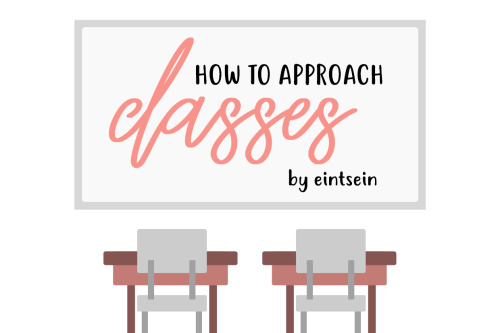
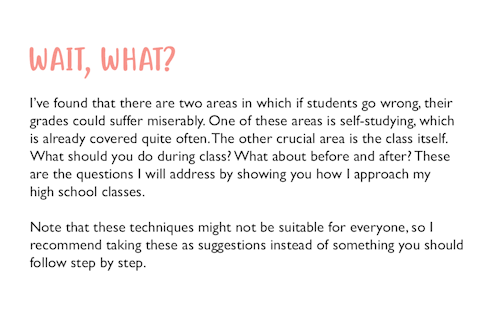
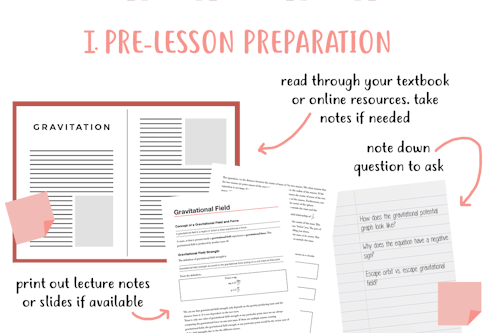
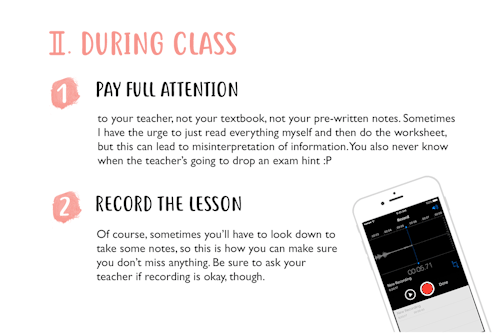
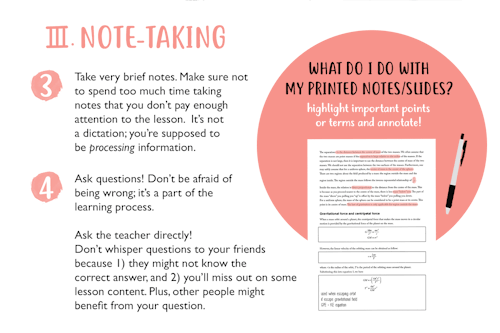
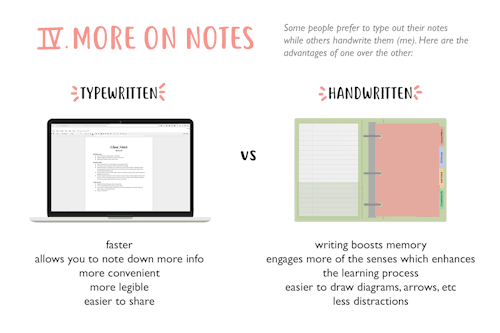
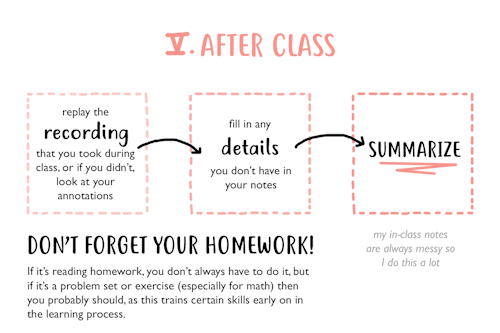
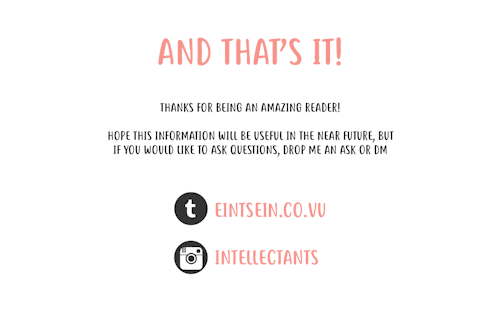
HOW TO APPROACH CLASSES A guide to getting the most out of your classes and lectures
By Eintsein
Design inspired by this post by @journalsanctuary
hello!! if u are applying to grad school (humanities or STEM!) & u
are trying to save money on application costs
are interested in programs that care abt saving u money on application costs
are interested in programs that are aware of the fact that the GRE tells them nothing of use about your academic abilities
this site may be useful to you as you decide where to apply :-)
College Textbook Lifehacks
Okay so it’s not the beginning of a semester but whatever. While I’m thinking about it, let me, a bonafide degree holder learn you some knowledge about college textbooks so you don’t have to take out a mortgage or try to short the market just so you can have a $1,000 paperweight that you never read.
Rule #1 I don’t care what your syllabus says or what your pre-semester welcome email from your professor says or what the bookstore website says, don’t buy the book before classes begin. Show up the first day and ask the professor if the book is necessary for passing the class. Sometimes, it’s not. Sometimes the professor teaches from his or her own memory and never consults the course textbook. If this is the case, unless you just love reading textbooks or want to keep them for whatever occupation you pursue once you have your degree, don’t get the book and save yourself some money. If he or she can teach the course without a book, you can pass it without a book.
Rule # 2 If your professor’s response is yes, you absolutely do need the book, ask them how different the required issue is from previous issues. Book publishers are dirty swindlers and will release a new edition of each book every year or two. Often times the new edition has minor changes like maybe now chapter 14 is split up into two chapters or they changed a couple of the review questions. If an older edition will suffice, just like iPhones, they will be a lot cheaper than the newest edition and you have a better chance of finding an even cheaper used copy which brings me to rule 3.
Rule # 3 Don’t buy the books from your university. Like publishing companies, universities also tend to be dirty swindlers. Copy the ISBN listed for your textbook and paste that shit into a site like half.com valorebooks.com or amazon.com where you will find discounted versions of most every textbook. You could also try to torrent them off of those sketchy russian sites that are listed under that post with the “Leak college textbook PDF’s not nudes” tweet but when that doesn’t work, you go to those sites I listed. Now you have to choose what quality you want, this is important because it can affect the resale value which I’ll talk about later. Obviously the higher the quality (New, Used-Like New etc.) will give you book without creases, markings etc. but will be more expensive. If you don’t care about this (again I’ll explain why you might care in rule 4), maybe go for the rental if the rental is cheaper than purchasing a high quality book-ONLY DO THIS IF YOU DON’T CARE ABOUT RESALE AND DON’T TEND TO MARK IN YOUR BOOKS. Otherwise, the choice is yours. Now you might ask, what will I do for the two weeks it takes to ship my book? This is where making friends in class comes in handy, just ask them to borrow their book for the time being, or better yet, if you have a close friend already in the class, split the cost of the book 50/50 and share it. If neither of these options work for you, visit your professor in his or her office hours, give them some BS like “I’m so sorry professor, I think I mixed up the shipping and billing address so it’s taking forever for the book to get here boo hoo feel bad for me.” Usually, professors have no problem photocopying the first chapter of the book for you or will be a little lenient with deadlines for the whole class if you’re not the only one. This is fun because not only do you get away with not buying the book right away, but you’re a hero for your class.
Rule #4 Even though it’s the beginning of the semester, think ahead to the end of the semester. Your university is going to offer to buy back your books at the end of the semester. Do not sell them your books, I repeat DO NOT SELL THEM YOUR BOOKS. Those dirty swindlers that sold you an overpriced book a few months ago? Yeah they’re going to buy it back for $5.00 or less. I don’t care if it’s a 10 lb, 700 page biology textbook that’s still in the plastic wrap, you will get cheated. Sell them on amazon. Seller accounts are free and though you aren’t likely to get 100% of what you paid for it back, you will make much more money selling there than you would to the school. If you bought the higher quality book and kept it in decent shape, you’ll get some good beer money. If you went with the $0.99 acceptable condition book, maybe don’t try and sell it on amazon because you’ll pay more to ship it than you’ll receive profit this is why it’s important to take into consideration whether or not you think you will mark up your book. Rentals are cheaper than buying new but you can’t mark them and can’t sell them but don’t worry, there’s other places you can sell your book if you bought a crappy one. Find out if your school has a student run for sale Facebook group (hint, it probably does, especially if you’re at a large state-school), advertise your books on the page and sell them for cash to a fellow student.
Rule #5 Sorry to say, but these rules don’t work for every course. You might have that professor that wrote their own book and makes you buy it which means you can’t find it on any third party website. When this happens, the most you can do is see if someone who has already taken the course still has their book so you can buy it from them. You can also leave a scathing review during evaluations at the end of the semester and on RateMyProfessor.com which may not do much but is good for the soul.
Also, especially for labs and beginning language courses, you may need to buy a workbook. Used ones are hard to come by but they do exist thanks to people like me who do their assignments on a separate sheet of paper so they don’t have to mark up the textbook and can resell it later (I advise doing this). This works for language courses, I don’t know how well it works for labs since I am not a science student, if it does work-sweet and if not-I’m truly sorry.
These are my rules and I promise they work. If any one else has additional hacks that they’ve figured out I’d love to hear them! Seriously, doing these things saved me a load of money.

Notes taken during Physics lessons! Exams end in 5 days and I can’t wait!!!!!!
This makes me sound stupid but what does a feynman diagram mean?
You don’t sound stupid! They can be pretty confusing at first, and I’m sure you’re not they only one that doesn’t fully understand them (myself included) so let’s learn how to draw Feynman diagrams!
You do not need to know any fancy-schmancy math or physics to do this!
I know a lot of people are intimidated by physics: don’t be! Today there will be no equations, just non-threatening squiggly lines. Even school children can learn how to draw Feynman diagrams. Particle physics: fun for the whole family.
For now, think of this as a game. You’ll need a piece of paper and a pen/pencil. The rules are as follows (read these carefully):
1. You can draw two kinds of lines, a straight line with an arrow or a wiggly line:

You can draw these pointing in any direction.
2. You may only connect these lines if you have two lines with arrows meeting a single wiggly line.

Note that the orientation of the arrows is important! You must have exactly one arrow going into the vertex and exactly one arrow coming out.
3. Your diagram should only contain connected pieces. That is every line must connect to at least one vertex. There shouldn’t be any disconnected part of the diagram.

In the image above, the diagram on the left is allowed while the one on the right is not since the top and bottom parts don’t connect.
4. What’s really important are the endpoints of each line, so we can get rid of excess curves. You should treat each line as a shoelace and pull each line taut to make them nice and neat. They should be as straight as possible. (But the wiggly line stays wiggly!)

That’s it! Those are the rules of the game. Any diagram you can draw that passes these rules is a valid Feynman diagram. We will call this game QED. Take some time now to draw a few diagrams. Beware of a few common pitfalls of diagrams that do not work (can you see why?):

After a while, you might notice a few patterns emerging. For example, you could count the number of external lines (one free end) versus the number of internal lines (both ends attached to a vertex).
How are the number of external lines related to the number of internal lines and vertices?
If I tell you the number of external lines with arrows point inward, can you tell me the number of external lines with arrows pointing outward? Does a similar relation hole for the number of external wiggly lines?
If you keep following the arrowed lines, is it possible to end on some internal vertex?
Did you consider diagrams that contain closed loops? If not, do your answers to the above two questions change?
I won’t answer these questions for you, at least not in this post. Take some time to really play with these diagrams. There’s a lot of intuition you can develop with this “QED” game. After a while, you’ll have a pleasantly silly-looking piece of paper and you’ll be ready to move on to the next discussion:
What does it all mean?
Now we get to some physics. Each line in rule (1) is called a particle. (Aha!) The vertex in rule (2) is called an interaction. The rules above are an outline for a theory of particles and their interactions. We called it QED, which is short for quantum electrodynamics. The lines with arrows are matter particles (“fermions”). The wiggly line is a force particle (“boson”) which, in this case, mediates electromagnetic interactions: it is the photon.
The diagrams tell a story about how a set of particles interact. We read the diagrams from left to right, so if you have up-and-down lines you should shift them a little so they slant in either direction. This left-to-right reading is important since it determines our interpretation of the diagrams. Matter particles with arrows pointing from left to right are electrons. Matter particles with arrows pointing in the other direction are positrons (antimatter!). In fact, you can think about the arrow as pointing in the direction of the flow of electric charge. As a summary, we our particle content is:

(e+ is a positron, e- is an electron, and the gamma is a photon… think of a gamma ray.)
From this we can make a few important remarks:
The interaction with a photon shown above secretly includes information about the conservation of electric charge: for every arrow coming in, there must be an arrow coming out.
But wait: we can also rotate the interaction so that it tells a different story. Here are a few examples of the different ways one can interpret the single interaction (reading from left to right):

These are to be interpreted as: (1) an electron emits a photon and keeps going, (2) a positron absorbs a photon and keeps going, (3) an electron and positron annihilate into a photon, (4) a photon spontaneously “pair produces” an electron and positron.
On the left side of a diagram we have “incoming particles,” these are the particles that are about to crash into each other to do something interesting. For example, at the LHC these ‘incoming particles’ are the quarks and gluons that live inside the accelerated protons. On the right side of a diagram we have “outgoing particles,” these are the things which are detected after an interesting interaction.
For the theory above, we can imagine an electron/positron collider like the the old LEP and SLAC facilities. In these experiments an electron and positron collide and the resulting outgoing particles are detected. In our simple QED theory, what kinds of “experimental signatures” (outgoing particle configurations) could they measure? (e.g. is it possible to have a signature of a single electron with two positrons? Are there constraints on how many photons come out?)
So we see that the external lines correspond to incoming or outgoing particles. What about the internal lines? These represent virtual particles that are never directly observed. They are created quantum mechanically and disappear quantum mechanically, serving only the purpose of allowing a given set of interactions to occur to allow the incoming particles to turn into the outgoing particles. We’ll have a lot to say about these guys in future posts. Here’s an example where we have a virtual photon mediating the interaction between an electron and a positron.

In the first diagram the electron and positron annihilate into a photon which then produces another electron-positron pair. In the second diagram an electron tosses a photon to a nearby positron (without ever touching the positron). This all meshes with the idea that force particles are just weird quantum objects which mediate forces. However, our theory treats force and matter particles on equal footing. We could draw diagrams where there are photons in the external state and electrons are virtual:

This is a process where light (the photon) and an electron bounce off each other and is called Compton scattering. Note, by the way, that I didn’t bother to slant the vertical virtual particle in the second diagram. This is because it doesn’t matter whether we interpret it as a virtual electron or a virtual positron: we can either say (1) that the electron emits a photon and then scatters off of the incoming photon, or (2) we can say that the incoming photon pair produced with the resulting positron annihilating with the electron to form an outgoing photon:

Anyway, this is the basic idea of Feynman diagrams. They allow us to write down what interactions are possible. However, you will eventually discover that there is a much more mathematical interpretation of these diagrams that produces the mathematical expressions that predict the probability of these interactions to occur, and so there is actually some rather complicated mathematics “under the hood.” But just like a work of art, it’s perfectly acceptable to appreciate these diagrams at face value as diagrams of particle interactions. Let me close with a quick “frequently asked questions”:
What is the significance of the x and y axes?These are really spacetime diagrams that outline the “trajectory” of particles. By reading these diagrams from left to right, we interpret the x axis as time. You can think of each vertical slice as a moment in time. The y axis is roughly the space direction.
So are you telling me that the particles travel in straight lines?No, but it’s easy to mistakenly believe this if you take the diagrams too seriously. The path that particles take through actual space is determined not only by the interactions (which are captured by Feynman diagrams), but the kinematics (which is not). For example, one would still have to impose things like momentum and energy conservation. The point of the Feynman diagram is to understand the interactions along a particle’s path, not the actual trajectory of the particle in space.
Does this mean that positrons are just electrons moving backwards in time?In the early days of quantum electrodynamics this seemed to be an idea that people liked to say once in a while because it sounds neat. Diagrammatically (and in some sense mathematically) one can take this interpretation, but it doesn’t really buy you anything. Among other more technical reasons, this viewpoint is rather counterproductive because the mathematical framework of quantum field theory is built upon the idea of causality.
What does it mean that a set of incoming particles and outgoing particles can have multiple diagrams?In the examples above of two-to-two scattering I showed two different diagrams that take the in-state and produce the required out-state. In fact, there are an infinite set of such diagrams. (Can you draw a few more?) Quantum mechanically, one has to sum over all the different ways to get from the in state to the out state. This should sound familiar: it’s just the usual sum over paths in the double slit experiment that we discussed before. We’ll have plenty more to say about this, but the idea is that one has to add the mathematical expressions associated with each diagram just like we had to sum numbers associated with each path in the double slit experiment.
What is the significance of rules 3 and 4?Rule 3 says that we’re only going to care about one particular chain of interactions. We don’t care about additional particles which don’t interact or additional independent chains of interactions. Rule 4 just makes the diagrams easier to read. Occasionally we’ll have to draw curvy lines or even lines that “slide under” other lines.
Where do the rules come from?The rules that we gave above (called Feynman rules) are essentially the definition of a theory of particle physics. More completely, the rules should also include a few numbers associated with the parameters of the theory (e.g. the masses of the particles, how strongly they couple), but we won’t worry about these. Graduate students in particle physics spent much of their first year learning how to carefully extract the diagrammatic rules from mathematical expressions (and then how to use the diagrams to do more math), but the physical content of the theory is most intuitively understood by looking at the diagrams directly and ignoring the math. If you’re really curious, the expression from which one obtains the rules looks something like this (from TD Gutierrez), though that’s a deliberately “scary-looking” formulation.
You’ll develop more intuition about these diagrams and eventually get to some LHC physics, but hopefully this will get the ball rolling for you.
USMLE STEP 1 STUDY TOOLS AND TIPS
It is approaching that time of year where the second year medical students are preparing to cram for the United States Medical Licensing Exam Step 1. A test some consider to be the most important exam of medical school and subsequently determines the rest of your life. That is a little dramatic but I think it should be your goal to do the best you can. Here are some of the tools I used to study for Step 1:
First Aid for the USMLE Step 1 2017
This is the holy bible of USMLE Step 1 studying. I highly recommend this book and I think almost every medical student who has taken the test would say the same. I would read through this book 2-3 times to really have it sink in.
Pathoma
A lecture series made by a certifiable genius: Dr. Husain Sattar, a pathologist from the University of Chicago. This series was amazing and incredibly detailed. A lot of high yield material is covered in his lectures.
https://www.pathoma.com
USMLE World
The question bank of all question banks. Though it may be school dependent, almost everyone from my medical school chose to go with this question bank. A couple thousand questions covering the majority of USMLE Step 1 topics. The questions are challenging but you will see your scores improve as you continue to study throughout your first and second year. I’ve even used this product for Step 2 and I am currently (literally open on my computer) using it for Step 3. My number one goal would be to complete every question offered in this question bank, it is a lot but well worth it.
https://www.uworld.com
The rest are to cover my weakest subjects from USMLE Step 1: Biochemistry, Microbiology and Pharmacology. I recommend the following tools to turn your greatest weakness into your greatest strength:
Microbiology
Clinical Microbiology Made Ridiculously Simple
Lange Microbiology and Infectious Diseases Flash Cards
Pharmacology
Clinical Pharmacology Made Ridiculously Simple
Lange Pharmacology Flash Cards
Biochemistry
Clinical Physiology Made Ridiculously Simple
Lange Biochemistry and Genetics Flash Cards

Based on this post
“Failure is the key to success"
We’ve all heard motivational quotes similar to the above. While they serve as an important reminder on our rough days, sometimes we need something more than hugs and well wishes to get us through.
You’ve failed. What next?
Let it out: Step back. Take a few days off. Shower, catch up on that sleep debt. Remind yourself of who you are outside your academic study. Catch up with a friend for coffee (or just get some coffee). Watch a movie, marathon a tv series, built a pillow fort, tumblr, youtube spiral - anything. Because your academic life is only one piece (of varying size) of a larger puzzle. Remind yourself of who you are outside of university/ school.
Formal/ Informal Avenues of Review : Check your school/university’s academic policies. Are you eligible to resit the exam? Were there any extenuating circumstances that affected your performance (e.g. medical, emergency etc)? Are you eligible to seek an adjustment to your marks? If you’re eligible, what documentation will you need to provide? Which staff member can you contact to follow up your application? If you’re not eligible, are there any other members of staff or advisor (e.g. course advisors, councillors, student leaders) you can discuss your circumstances with?
Reset, Recuperate, Retake: It is likely that you will need to repeat or retake the class/ assessment/ unit. That’s ok. Seek feedback from your lecturer/ tutor or teacher. Consolidate your strong areas. Focus on the areas of the course you find challenging. Use the feedback given to target your study time!
Same Shit, Different Day: While the content may be the same, using a different method to study may be more effective ( see below)
Same content? Change it up!
flashcards by @illolita,
colour coding
audio recordings by @riseandstudy,
mindmaps by @reviseordie
sticky notes @etudiance
Change your study habits by @whilwheaton
Practice past papers. (see below).
Something to help you get back up on your feet
Videos and speeches to help you push through
On being wrong
On regret
On making difficult choices
On what the fuck to do with your life
On "falling behind”
On rushing things
On success
On motivation - for recent graduates
On perspective by @fishingboatproceeds
Just do it
Find songs to cry and scream to
8tracks and this spotify playlist
Classical music for any mood by @violaboss
Find something on the Nostalgia Machine
Infinite Jukebox
Make your own music
IDGAF by Watsky “Let me tell you about my GPA, four-O, straight A’s and my- idgaf!”
Something to help you fucking laugh or smile
Honest Trailers
Dance Mashup
Thomas Sanders @thatsthat24
This kid and this kid
Goat Remixes
This vine
Need more?
Cute flash games (+amazing background music)
Motivation wall by @study-ings
Mug Cake by @sortedfood
Calming Manatee
Ultimate motivation song
SCREAM INTO THE VOID (personal favourite)
Things to remember
Oi, have you ever failed anything?
Yes. See here
Graduation is a journey.
Yes, studyblr makes studying look glamourous, neat, aesthetic, "oh, look how these _____ notes helped me get an A+.” But writing notes, having fancy pens, using apps (whilst useful) only form one part of a larger narrative.
The reality is much less appealing. The road to graduation is not a fairytale. The road to graduation is fucking tough. It may involve tears, frustration, all nighters, crippling anxiety and unhealthy levels of caffeine consumption. One set back does not knock you off the path to graduation. Setbacks are arguably a part of the journey.
Sometimes, hard work and effort will not translate into results.
There’s a special brand of frustration that comes with dedicating the past month/week/ year to a particular project and not achieving your desired result/ grade. It stings like a bitch and is often accompanied by a sense of doubt.
Check that you’ve followed your syllabus. Accept that there may have been factors outside of your control. Revisit the process - what did you enjoy? What did you learn from the mechanics of the process?
The value of hard work does not necessarily lie in the result attained; nor is the result attained a reflection of the worth of your efforts.
Experience is an advantage
Retaking the test/assessment/ unit can be an advantage. You know what questions to expect. More importantly, you know how you react under exam conditions. Prepare. Plan your exam time. Will you start the exam paper from the beginning or the end and work backwards?
Use this experience in those pesky interview questions! (e.g. the good ol’ “tell me about a time you failed”)
Perfection is not a prerequisite to success
Ah, my pesky perfectionist tendencies. At times, I must remind myself that I don’t need to be perfect in order to reach my goal. Not having the latest app, 10 different coloured pens, that fancy notebook, the newest edition of the textbook does not mean I’ve automatically failed. I just have to be more resourceful.
Just start. Work with what you have, to the best of your ability. Yes it may be difficult; you might need to access extra resources online, or find material from other sources. Your notes may all be in the same colour, or spread over three different notebooks. But success will not be an option unless you start.
Other useful tips
On bad semesters by @post–grad
This masterpost by @areistotle
Reducing stress by @mindpalacestudy
How to fail by @psychstudyblr
A final note…
You’ve probably been through hell to get to where you are. Celebrate your achievements - don’t diminish them. Build a support network (heck, at the very least make a youtube playlist of funny videos). You’ve passed an exam before. You’ve endured X number of years of formal academic education. Sure, each exam is slightly different and each comes with its customised brand of torture. No two exams are exactly the same. But have confidence in yourself - you’ve picked up some transferrable skills along the way - determination, resilience, the endurance to pull all nighters.
Whether you’ve been a straight A student up to this point, a masters student or top of the academic pyramid, failure is going to be one of those annoying things you’ll eventually face.
What you do with it?
Well, that’s where shit gets interesting.
All the best,
-fuckstudy
Masterposts are posted every other Monday (asia pacific)/ Sunday (everywhere else). See previous masterposts here. Feel free to request topics here.
previous topic: law 101 - how to read case law

scholarships are the bomb!! free money to get urself an education!! here’s my best advice aaand resources for applying + getting some of that sweet sweet money :D
advice
use all of the databases!! the scholarships are right there for you. Take advantage of them, srsly!!! many let you input your criteria + they’ll match you up with some, and they help to organize your applications. You can subscribe to their newsletter and get alerts for new scholarships. there’s a whole bundle below all this advice to getchu started :D
start early + don’t stop: your eligibility for scholarships starts pretty much freshman year of high school, and basically doesn’t stop until you’re out of education, so take advantage of them!!! Logically, applying to more gives you a higher chance of winning one, so keep ploughing through them
don’t let essays scare you off: sweepstakes scholarships are easiest to apply for, but this also means they have more applicants. Do your best work + put time into essay-based scholarship contests, and up your chance of winning something!! Factor them into your normal routine like you would a homework assignment and just keep at it.
keep track of what you’ve applied for: seriously. Do it. It’ll motivate you when you’re not feeling like it, + keep you organized. Set up a spreadsheet (google sheets, excel, whatever floats your boat) and give it 5 columns: title of the scholarship, amount worth, whether or not you’ve applied, if you were successful, + the organization offering it. It’s also a great reminder of scholarships to reapply for next year.
check local scholarships: they’re waayyyy more restricted so the applicant pool is a lot smaller!!! Check your school, organizations you belong to, your parents’ companies, + local businesses. You’ll be competing against people in your town/county/district + it’ll give you a much better shot at winning. Check out your school’s website + talk to your guidance counsellors!
be specific: narrow down that applicant pool early. When you’re googling, look for scholarships that will apply only to you, so don’t just search ‘scholarships’. Look for ‘scholarships for bisexual women’, or ‘scholarships for international students’, or ‘scholarships for left-handed volleyball players’. Less applicants=better outcomes.
don’t apply to scams: be wary!!! Two big things: be careful of scholarships which want you to pay to apply, and guaranteed scholarships. Research pay-to-apply ones to make sure they’re legit. There’s more info here, here, and here on avoiding scholarship scams. Stay safe!!
scholarship databases
unigo goodcall scholarships.com niche scholarshipmonkey fastweb chegg cappex dosomething scholarshippoints nextstudent college board
more scholarship masterposts
college scholarships masterpost by @wonderstudying
how to search for scholarships by @adamparresh
scholarships! by @the-regular-student
it’s ya girl’s college scholarship masterpost by @jesussbabymomma
scholarship 101 by @thisexpedition
scholarships: how to find them and apply by @futurecristinayang
good luck!! you’ve got this :D

Organic Chemistry Masterpost
As a chemistry major, I’ve taken sophomore organic chemistry and advanced organic chemistry. I know it’s a highly popular class, so given the demand, I figured I’d contribute some materials I’ve used that led me to success in those classes.
Google Drive:
I have set up a Google Drive folder containing much of these resources I’ve used to study from, and eventually tutor, the class. They are organized in folders by semester.
Summary Sheets
Practice “Workshop” Problems
Practice Exams
Class Notes
Research Papers
Lab Reports
“The Six Pillars of Organic Chemistry” PDF (written by my professor!)
If I end up finding additional resources, I will add more to the Drive. But that should do you well! You can check the original post for updates here.
Study Tips:
Preparing for Organic Chemistry by @hexaneandheels
Survivng Orgo Lab w/ Awful Partners by @hexaneandheels
How I Study for Organic Chemistry by @thekimmydiaries
The 10 Commandments of Organic Chemistry by @theorgounderground
Survival 101 In: Organic Chemistry by @chemistrynerd2020
Helpful References from @theorgounderground
Basic Survival Skills
Intermediate Survival Skills
Advanced Combat Skills
Reaction Mechanisms
Master Chart of All Reactions
Substitution vs. Elimination
Printables:
Reaction Table & Reaction Chart by @colllegeruled
Line Reactions & Mechanisms by @studygene
Best YouTube Channels for Orgo:
Leah4Sci (she was my goddess; check out her website, too!)
Khan Academy Organic Chemistry
Master Organic Chemistry (also check out his website!)
The Organic Chemistry Tutor
Other Recommendations:
Organic Chemistry as a Second Langauge (THE BIBLE)
Klein Textbook >>> McMurry Textbook (IMO; my professor assigned McMurry)
Molecular Visions Molecular Modeling Kit
ChemWiki
Really, this class is not as hard as people make it out to be. If you put in the work, it’s easy to understand. Practice problems are your friend. If your professor assigns “optional” homework, do it anyway. My professor did a “mechanism a day”, which is something you should absolutely do on your own if your professor doesn’t! At times it might be frustrating, but be patient. Your hard work will pay off!
Good luck!
– Melissa (@hexaneandheels )
Study Tips | FAQ in Academia | Printables | YouTube | Instagram
-
 xenonz reblogged this · 1 week ago
xenonz reblogged this · 1 week ago -
 gloomin liked this · 3 weeks ago
gloomin liked this · 3 weeks ago -
 bludguts liked this · 1 month ago
bludguts liked this · 1 month ago -
 chancellorcannoli reblogged this · 1 month ago
chancellorcannoli reblogged this · 1 month ago -
 spaghettiwritten reblogged this · 2 months ago
spaghettiwritten reblogged this · 2 months ago -
 bycariann liked this · 3 months ago
bycariann liked this · 3 months ago -
 saintkitten liked this · 3 months ago
saintkitten liked this · 3 months ago -
 sorryforcaringlover reblogged this · 3 months ago
sorryforcaringlover reblogged this · 3 months ago -
 sorryforcaringlover liked this · 3 months ago
sorryforcaringlover liked this · 3 months ago -
 turnabouted liked this · 3 months ago
turnabouted liked this · 3 months ago -
 goodnightjohnny liked this · 3 months ago
goodnightjohnny liked this · 3 months ago -
 nycdasofficecouch liked this · 3 months ago
nycdasofficecouch liked this · 3 months ago -
 wellheavenknows liked this · 3 months ago
wellheavenknows liked this · 3 months ago -
 permanentsharpie liked this · 3 months ago
permanentsharpie liked this · 3 months ago -
 lah-reina liked this · 3 months ago
lah-reina liked this · 3 months ago -
 darkstoriesofthenorth liked this · 3 months ago
darkstoriesofthenorth liked this · 3 months ago -
 sinnersmovie reblogged this · 3 months ago
sinnersmovie reblogged this · 3 months ago -
 apfelhalm liked this · 3 months ago
apfelhalm liked this · 3 months ago -
 phonethip liked this · 4 months ago
phonethip liked this · 4 months ago -
 magpiethevagabond reblogged this · 5 months ago
magpiethevagabond reblogged this · 5 months ago -
 dwelamong reblogged this · 5 months ago
dwelamong reblogged this · 5 months ago -
 ewiza reblogged this · 6 months ago
ewiza reblogged this · 6 months ago -
 ap-central liked this · 6 months ago
ap-central liked this · 6 months ago -
 muffinsandviolence liked this · 6 months ago
muffinsandviolence liked this · 6 months ago -
 taleasoldasonceuponatime liked this · 6 months ago
taleasoldasonceuponatime liked this · 6 months ago -
 crocomom liked this · 7 months ago
crocomom liked this · 7 months ago -
 risefromthesea-tothesky liked this · 7 months ago
risefromthesea-tothesky liked this · 7 months ago -
 pseuglam liked this · 7 months ago
pseuglam liked this · 7 months ago -
 paynomind-iamnotreal liked this · 8 months ago
paynomind-iamnotreal liked this · 8 months ago -
 in-shades-of-gray reblogged this · 9 months ago
in-shades-of-gray reblogged this · 9 months ago -
 alanxkjciwkwn liked this · 9 months ago
alanxkjciwkwn liked this · 9 months ago -
 storiesinatimemachine liked this · 9 months ago
storiesinatimemachine liked this · 9 months ago -
 otpancake liked this · 9 months ago
otpancake liked this · 9 months ago -
 themuseinmuseum liked this · 10 months ago
themuseinmuseum liked this · 10 months ago -
 sub-stances liked this · 10 months ago
sub-stances liked this · 10 months ago -
 let-the-wingless-ones-fly liked this · 10 months ago
let-the-wingless-ones-fly liked this · 10 months ago -
 terrylicious reblogged this · 10 months ago
terrylicious reblogged this · 10 months ago -
 mujercasosdelavidareal liked this · 10 months ago
mujercasosdelavidareal liked this · 10 months ago -
 arsxnoe reblogged this · 11 months ago
arsxnoe reblogged this · 11 months ago -
 sillymoes liked this · 11 months ago
sillymoes liked this · 11 months ago -
 thegirlofthebrowneyes liked this · 11 months ago
thegirlofthebrowneyes liked this · 11 months ago -
 komodocloud liked this · 11 months ago
komodocloud liked this · 11 months ago -
 bruh182 liked this · 11 months ago
bruh182 liked this · 11 months ago -
 afunnystory liked this · 1 year ago
afunnystory liked this · 1 year ago -
 entrecielosazules liked this · 1 year ago
entrecielosazules liked this · 1 year ago -
 thesoleofmysoul liked this · 1 year ago
thesoleofmysoul liked this · 1 year ago -
 f0ydownn reblogged this · 1 year ago
f0ydownn reblogged this · 1 year ago
a study blog for collected references, advice, and inspiration
267 posts



